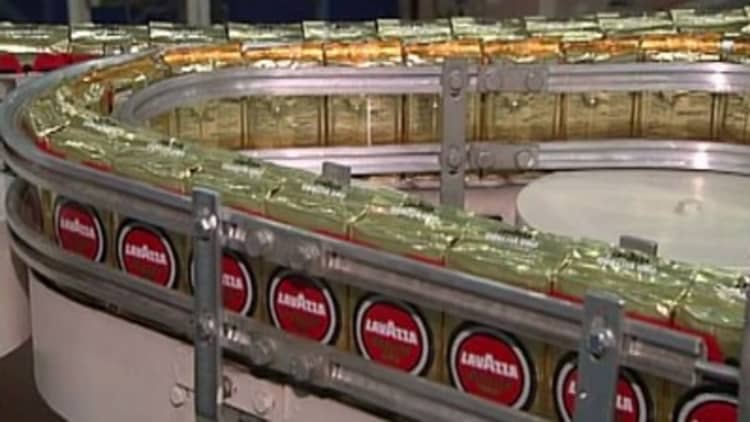
Italian coffee manufacturer Lavazza has its sights set on taking a larger stake of the American coffee market.
"We were a tiny, sexy, profitable niche business with the restaurants and the cafes," said Lavazza North America CEO Ennio Ranaboldo. "What we were really missing was a significant grasp of the American consumers' minds."
Lavazza says it's currently worth $1.7 billion, and it posted an operating profit of about $139.9 million at the end of 2014, up 16 percent from the year before. But, having the majority 44.9 percent market share in Italy per Nielsen is one thing. It's not an easy path to U.S. coffee industry domination, considering there's a very visible established brand — Starbucks — on every corner.
Instead of trying to open up retail locations, Lavazza is trying another approach: If you can't beat your competitor with quantity, show off your quality.
"We believe it's a correct marketing strategy for a brand that is growing that has a premium side attached to it, but it's mostly an inclusive brand," Ranaboldo said.
There may be room for growth in the U.S. coffee market. According to the Specialty Coffee Association of America, the U.S. coffee market is worth between $30 billion and $32 billion annually, with specialty coffees making up a 37 percent volume share but almost 50 percent of its value.
Lavazza, which is currently the world's seventh-largest coffee roaster, is increasing its North American products and advertising efforts as a way to introduce itself as the premium cup of joe. In addition to spending $20 million on its broadcast ads in the U.S., the 120-year-old coffee brand is aligning itself with high-end partners like the U.S. Open and the Guggenheim Museum in New York during its first full North American advertising campaign.
Lavazza's efforts will only continue to strengthen throughout 2016, as it rolls out new products for American in-home consumption and more partnerships in out-of-home locations like hotels, upscale cafes, cruise ships and other hospitality locations.
"As much as we love espresso, it's drunk by a minority of consumers," Ranaboldo said. "Already the ability of expanding the lineup to include other specialty beverages was a major achievement. Now, we have a full lineup of drip coffees tailored for the American consumer."
For example, Lavazza recently sponsored Italian artist Alberto Burri's "The Trauma of Painting" exhibit at the Guggenheim. Corporate image director Francesca Lavazza said the partnership was a good way to show the brands commitment to international art, as well as Italian culture.
"In Italy, especially with Lavazza, coffee is a kind of art," she said. "It's not a product, but it's a way of life. It's a style. It's a sort of social way to connect with people, and art is the perfect language to connect."
Ad agency DiMassimo Goldstein (DIGO Brands) CEO Mark DiMassimo said Lavazza's advertising plan could work for them. He said that when entering a market, brands can take different strategies. One way is try to get in front of as many consumers as possible using high-profile events.
While it will get your brand out there, he warned the tactic has some downsides. DiMassimo said that while Starbucks is known to everybody, it's only established itself as one level up from brands such as Dunkin' Donuts by its mass market approach.
"What lifestyle marketers have found is, it's very hard to move in perception in the middle-of-the-road market," he said.
The other path, which Lavazza seems to have taken, is to align itself with high-end events and products to create an aura of eliteness. Ben Hordell, founding partner of digital marketing agency DXagency, said that when consumers look at the grocery shelf, he said they're choosing Starbucks because of name recognition. But, you won't see the growing number of U.S. coffee enthusiasts "trumpeting the quality of Starbucks," he said. (Starbucks did not respond to a request for comment.)
Lavazza's coming from Italy automatically gives it a branding boost from being associated with a country known for quality coffee, he said.
"Coffee has become on the same lines as wine and beer," he said. "People are becoming coffee snobs. It's about good coffee, and it's about the roasts and origins."
By becoming the product of choice for affluent influencers, DiMassimo said Lavazza makes the average consumer who aspires to live that lifestyle want that brand. That said, he believes there's plenty of space for a new brand to make itself known as the coffee for the connoisseur.
"People care a lot more about lifestyle and experiences, and they'll spend more for a unique experience," DiMassimo said. "A little reward like a better coffee is a little way they can reward themselves every day."




